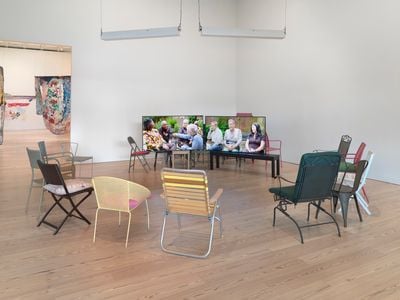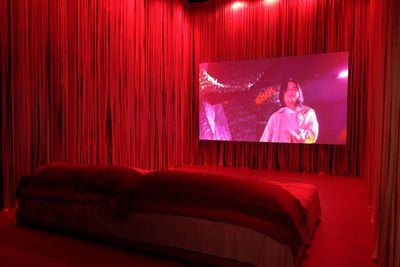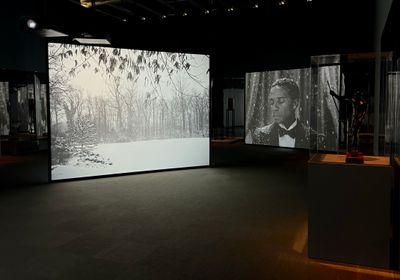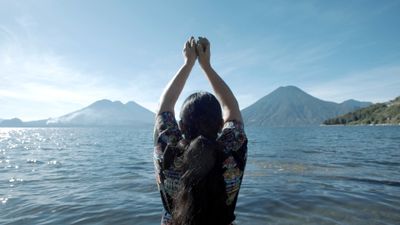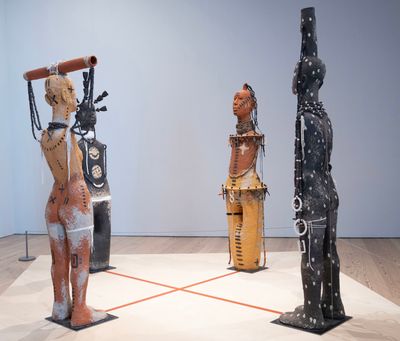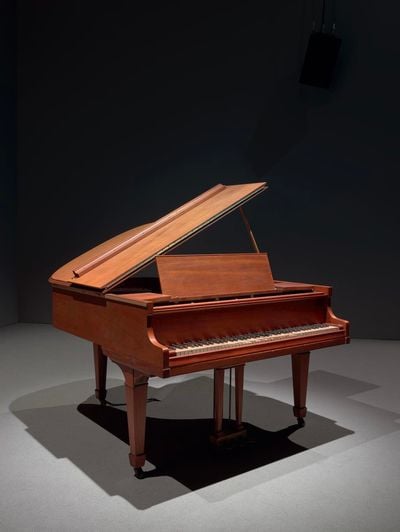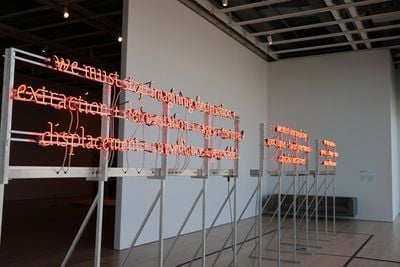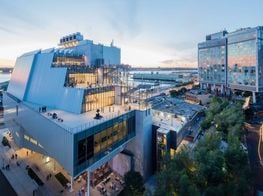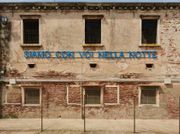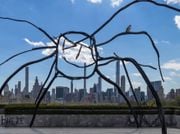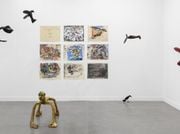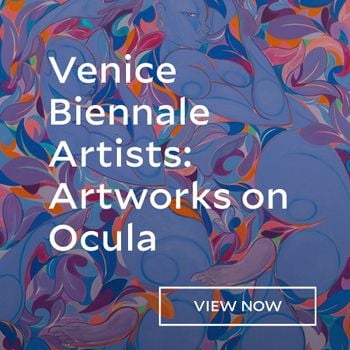At the 2024 Whitney Biennial, What is Touched Touches Back

Charisse Pearlina Weston, un- (anterior ellipse[s] as mangled container; or where edges meet to wedge and [un]moor) (2024). Exhibition view: Whitney Biennial 2024, Even Better Than the Real Thing, Whitney Museum of American Art, New York (20 March–11 August 2024). Photo: Nora Gomez-Strauss.
Amid light-year advances in AI and genocidal violence unfolding across social media, prompting artists to re-examine boundaries between the body and its surrounding networks, natural and artificial, the 2024 Whitney Biennial adopts a refreshingly tactile, grounded point of view.
Discarding overtly conceptual works known to previous editions, Even Better Than the Real Thing (20 March–11 August 2024)—rolling off Bono's tongue in U2's 1991 album Achtung Baby—presents works by 71 artists and collectives who engage with overlooked histories and mythologies, diasporic forms of bodily archiving, and personal-familial storytelling.
The media landscape that gave rise to U2's affectionate lyricism of 'You're the real thing' with a music video featuring a young Jeff Koons and then-porn-star-wife Cicciolina, has clearly evolved. Today, the proliferation of simulation technologies promises a future divorced from colonial, racial, and gendered legacies. This rapid pace is asking for artists to critically re-situate the body and frameworks of reality.
The Biennial hones in on the bodily and the experiential. It gives ample space to each installation and allows viewers to take the time to walk around, lie down, and reflect. Sound pieces installed in the Whitney's staircases and elevators infuse the floors with a siren-like soundscape, setting up a somatic feedback loop found in many of the works on view.
A thread running across multiple films and multimedia installations is re-enactment and fragmentation. In Her Time (Iris's Version) (2023–2024) by Diane Severin Nguyen introduces an actress rehearsing for a film about the 1937 Nanjing Massacre. The film, shot with dazzling cinematography in a film production complex in Zhejiang, China, cuts between the obviously staged—a Japanese squadron portrayed by migrant workers breaking into disco dance—and the subtly emotive, as the actress questions reality from a feminist lens.
As with Nguyen's work, which invokes re-enactment to complicate historical narratives and inner subjectivity, Isaac Julien's Once Again . . . (Statues Never Die) (2022) turns to cinematic restaging to explore dialogues between queer cultural visionary Alain Locke and Albert C. Barnes, the collector and founder of the Barnes Collection.
The five-screen installation, accented with neoclassical bronze figures and contemporary sculptures, transports viewers to a black-and-white universe. On-screen, Black performers peruse collections of African art, their movements mirroring the audience's travelling through the space. As tension arises between Barnes, musing on his promotion of 'primitive African statues', and Locke, warning against the exoticisation of Black modernist art, Julien's work invites us to dance in a reflexive ballad of gazes and interpretations.
This cross-dimensional engagement with historical legacy and collaboration with contemporary peers is also found in the interdisciplinary works of Clarissa Tossin.
Before the Volcanoes Sing (2022) builds on the artist's 2019 series of 3D-printed terracotta replicas of pre-Columbian Mayan wind instruments. The film follows protagonists as they weave through twists and turns in Guatemalan architecture and Mayan logograms, interwoven with haunting performances by flautist Alethia Lozano Birrueta activating the replicas.
Building on Tossin's rumination on Indigenous cosmologies, the Biennial sees many artists employing myth and spirituality to navigate the fluidity between their identity and ancestral heritage. In Rose B. Simpson's 'Daughters: Reverence' series (2023–2024), four larger-than-life clay figures, each over two metres tall, are installed to form a protective circle of sacred energy, connected by ancestral motifs of beads and textured engravings.
By generating awareness of a body's orientation, embodiment produces disorientation, and hopefully, reorientation towards how we choose to exist in the world.
With a web and software-informed aesthetics, Eamon Ore-Giron's 'Talking Shit' paintings series (2023–2024) reimagine Peruvian and Mexican mythology, rendering the serpent deity Amaru and the Inca god Viracocha through symmetrical geometries and gradient colours.
Like the interconnectedness between ancestral folklore and identity-making, artists' usage of materials highlights the poetic reciprocity between the hand, its moulding of material, which then sculpts experience.
Crocheting with copper wire and lace, ektor garcia created a series of sculptures with large-scale, intricate patterns that morph between abstraction, flora, and body parts, playing with transparency, shadows, and framing. These lightweight materials both showcase and allow for garcia's itinerant studio practice between the U.S.-Mexico border.
The diasporic, person of colour experience, when negotiating queerness and cultural complexity, often involves a split between integration and alienation, at-homeness and dysphoria. The skin that holds them is simultaneously a home and that which marks them with racialised and gendered difference. That dichotomy is heightened in the works of Lotus L. Kang and Jes Fan.
Kang's installation In Cascades (2023–2024) features floor-length scrolls of photographic films in a constant state of exposure. These scrolls, between ombre hues of yellow, burnt orange, and black, are testaments of change that respond to imprints of light, as would skin under sunlight. The body's metaphorical presence is captured by Fan's biomorphic, sculptural self-portraits, with holes in the wall inverting CAT scans of his stomach into the skin of a cave.
Can technology be used to expand, invert, and contract time and space? Persistently, hauntingly, the body is somehow always present. Nikita Gale's TEMPO RUBATO (STOLEN TIME) (2023–2024) traces the contours of an absent body with a custom-made piano stripped of its melodic functions, communicating solely in percussive vibration.
This rhythmic quality finds its way into Stuttering Can Create Time (2023), a billboard by the collective People Who Stutter Create. Installed on the façade of a building across from the Whitney, the work riffs on the way stammering and communication differences can transform time through repeating, stretching, and pausing.
As AI companies try to dissociate the 'magic' of their simulation models from the bodies of clickworkers trained in prison and the Global South, the Biennial orients itself towards history and collective reenactment, myth and personal identity, rhythm and time, revealing their messy entanglements. In her 2006 book Queer Phenomenology, Sara Ahmed writes: 'Orientations are tactile and they involve more than one skin surface: we, in approaching this or that table, are also approached by the table, which touches us when we touch it.'
By generating awareness of a body's orientation, embodiment produces disorientation, and hopefully, reorientation towards how we choose to exist in the world. Perhaps what is even more real, is that in the flickering neon letterings of Demian DinéYazhi, the artist has hidden the words 'Free Palestine', without the museum's prior knowledge. The work, looking out to the Hudson River on the West, speaks directly to the powers of institutions in touching and shaping us, who in turn, touch and shape back. —[O]

